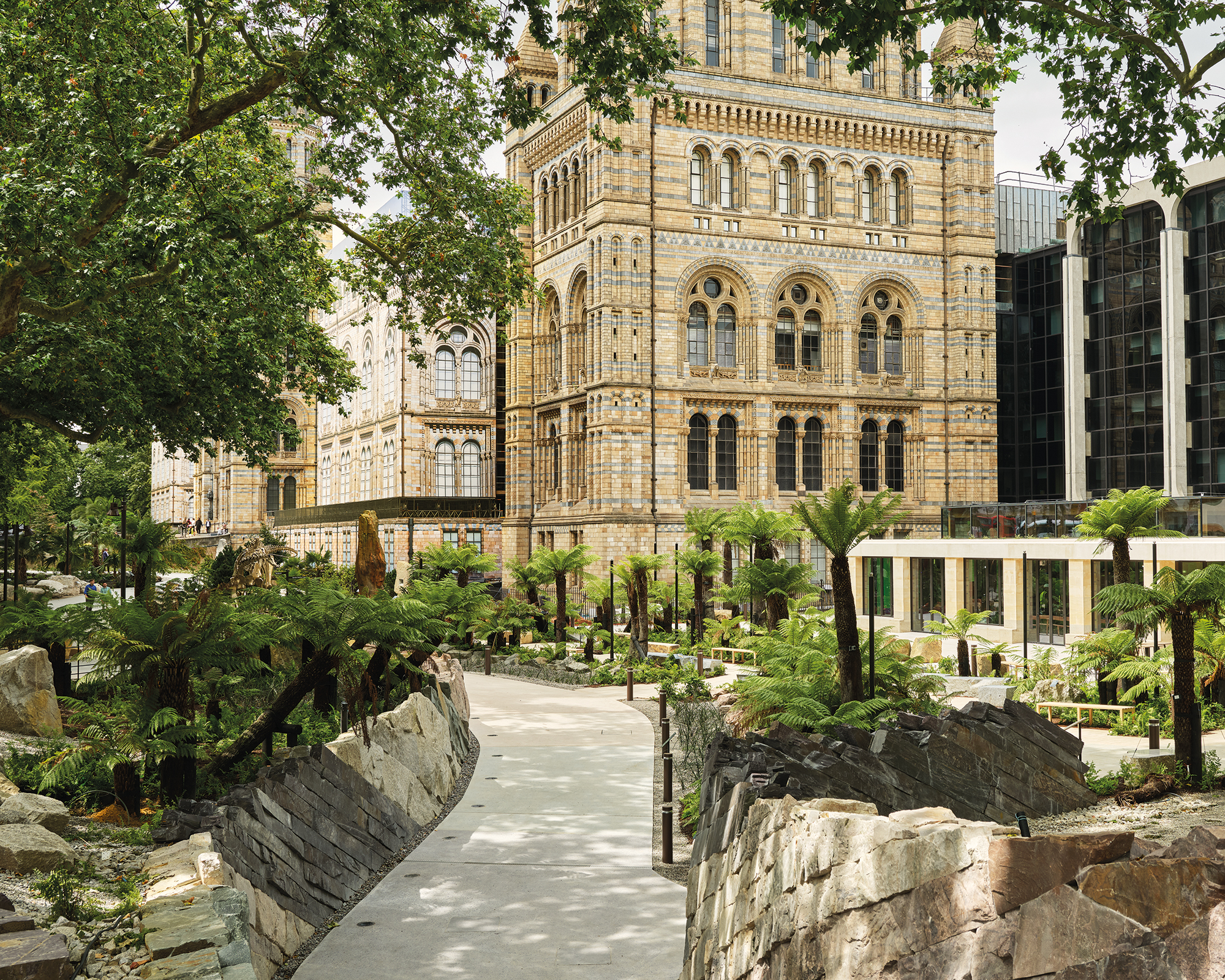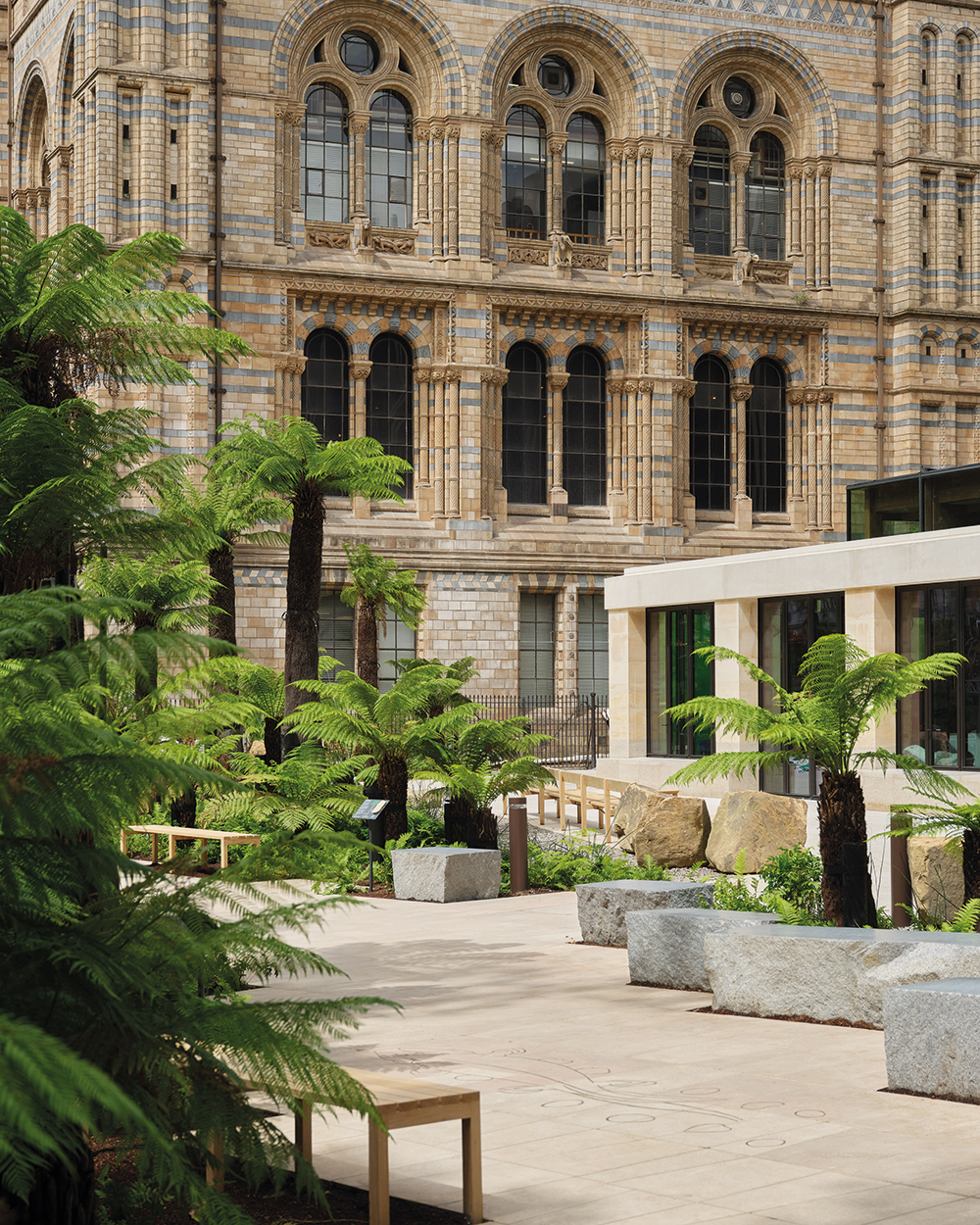
Isabel Hardman has narrated this article for you to listen to.
The Natural History Museum is one of the most beautiful buildings in London, but its gardens have long been a bit boring – just a pavement on the way in to Alfred Waterhouse’s ornate ‘cathedral to nature’. Most people noticed them solely when the ice rink appeared at Christmas. There was a wildlife garden in one corner that only real enthusiasts (like me) bothered to visit.
Where else in London could you walk three billion years along pavements this good?
With this enormous overhaul of the site, that’s all changed. The scale of the Evolution Garden, designed by landscape architects J&L Gibbons and architects Feilden Fowles, is enormous, both in size and the period of time it covers. Instead of hauling yourself up a sharp flight of steps from the Tube, you now saunter through a ravine of rocks, three billion years old. These huge, crashing cliffs start with the oldest rock in the British Isles, Lewisian gneiss, and move through Torridonian sandstone, Cambrian quartzite and Welsh heather slate. The rocks continue through the Evolution Garden, creating spines and barriers to divide rampaging children from the new planting. You can enjoy those plants from a series of benches also hewn from interesting rocks, including some striking, beautifully smooth white chalk and flint benches.
I will get on to the planting in a minute, but the bones of this design are beautiful too. The pavements are really very clever. They teach you things without ever being earnest: the brass inlays describe fossils, geological eras and processes such as volcanic eruptions and extinctions. By the time the path reaches the end of the garden, human footprints emerge and the terrazzo throws up evidence of human life, including shards of blue grass, pottery and plastics.
Humans come on to the scene pretty late, and so do flowers, which is why the planting is largely foliage-focused. Hundreds of huge tree ferns dominate the understory of the even bigger plane trees that tower above. There are smaller ferns such as Dryopteris affinis, and early grass-like plants including Carex, while Pachysandra terminalis covers the ground with its glossy, evergreen leaves. This is both accurate, in evolutionary terms, but also means that the garden still looks great, even in the colder months.
Conifers, including the truly prehistoric Wollemi pine, Wollemia nobilis, and various dwarf forms of pine, sit underneath the huge bronze cast of a dinosaur skeleton. Magnolias are an honourable flowering exception in the design: they evolved before bees and were pollinated by beetles, which is why their waxy flowers are so thick and robust.
When the development was first mooted, there was a furious campaign against the changes. The wildlife garden used to be a peaceful space, quite messy and enclosed. The campaigners were worried about the disruption to the ecosystem. Their concerns were entirely understandable but have turned out to be misplaced.
The garden still has piles of dead wood to attract invertebrates and encourage fungi. It still has a wildlife pond, meadowy parts and looser areas of coppiced hazel, brambles and ivy. But they are now framed within a more intentional design that everyone can get close to. A sweeping terrazzo path takes you right into the centre of the pond, which is still gloriously messy and teeming with life. A classroom harvests rainwater from its roof and channels it along a rill and through swales, storing it underground. Most designers would be happy just with the latter, but this lot have actually managed to make the drainage system beautiful, too.

Elsewhere in the wildlife garden, more brass inlays intersect the path like tree roots. One tree stump has a secret brass cast of an earthstar on its side. It is beautiful and thoughtful – and you don’t often get to say that about hard landscaping in the public realm, let alone a project that was initially threatening to undermine a wildlife garden, not enhance it.
In fact, it’s the hard landscaping that’s the real joy of the whole set of gardens around the museum. Yes, the big bronze cast of the diplodocus is impressive, and yes, the planting is inspired.
But where else in London could you walk three billion years along pavements so good that you want to photograph them? It’s a triumph, and deserves its place at the foot of Waterhouse’s wonderful building. You might even forget to go inside.
The Natural History Museum’s Evolution Garden is free to visit and open daily from 10 a.m. to 5 p.m.









Comments